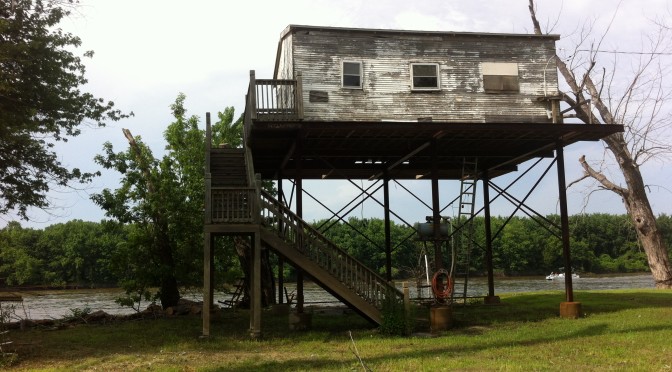In 2009 we finally had the cabin raised.
Prior to the flood of 2008, the cabin was supported on 9′ concrete piers. After raising, the floor of the cabin is now 19′ off the ground…safe above the 500 year flood plain.
For those who have never renovated a cabin with a floor height that’s 19 feet above the ground, a whole new set of obstacles comes into play. The first thing you’ll realize is that you can no longer have someone hand a board up to you from the ground while you’re standing on a work platform that’s level with the floor of the cabin. For those of you who are still in your teens or twenties, this may not be a big deal. However, when you add another 40 years to the equation, those 32 steps from the ground to the floor of the cabin become a deal breaker unless you develop some means of lifting your construction materials up to the cabin floor.
Not having continual access to a high lift and doing the work myself on a limited budget, I’ve found the best materials lifting solution to be a transom mounted electric hoist. After some research on the internet and viewing of some local hoisting solutions, I came up with the following system…
With a lifting platform which measures approx. 97-1/2″ x 42″, I can easily accommodate 8 foot lumber and 4′ x 8′ sheets of sheathing, drywall or plywood. Somewhat larger objects can also be hoisted using a little ingenuity (note: I’m still working on a solution for 16 foot long sections of siding…however, everything’s fine for now).
The first order of business after raising the cabin was to create work platforms along three of the sides. The next project was removing two layers of shingles, repairing the roof sheathing and installing new shingles.
My current project involves replacing all of the cabin walls from the floor to the ceiling joists, since the lower sections of the wall studs have rotted due to many years of sporadic, prolonged exposure to flood water. This is being accomplished by jacking up small sections of the roof, cutting out sections of wall studs (8 feet or less) and tilting up pre-fab’d wall sections to replace those studs which were removed. This is somewhat tedious, but so far it appears to be working well.
Currently, the two long walls have been re-studded, sheathed and temporarily covered. The replacement of the end walls will begin as soon as the latest round of flooding subsides.
I at least do once a month levitra reviews and therefore I can tell with confidence that each who will try simply make it can be upset. Seals won’t be able to help you.




